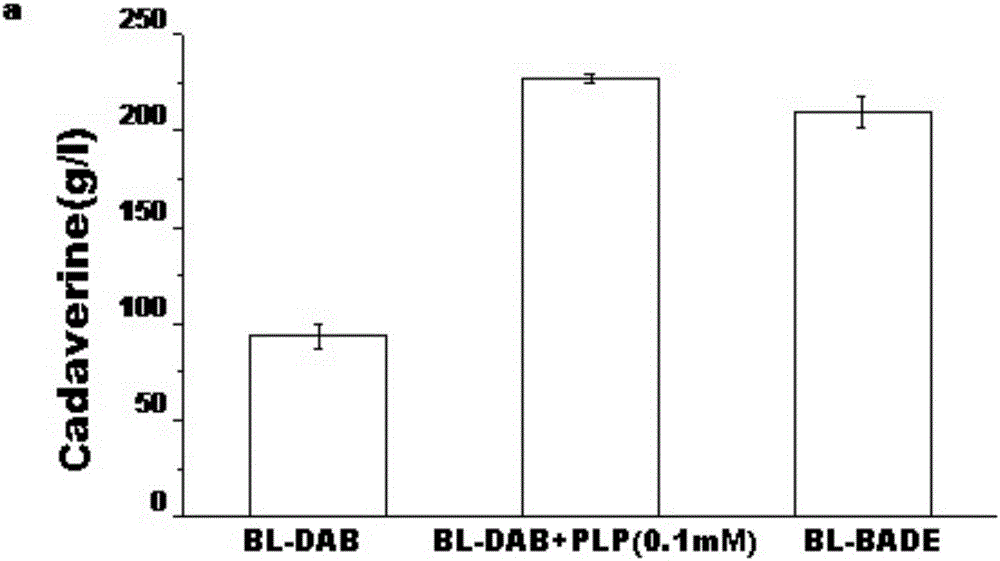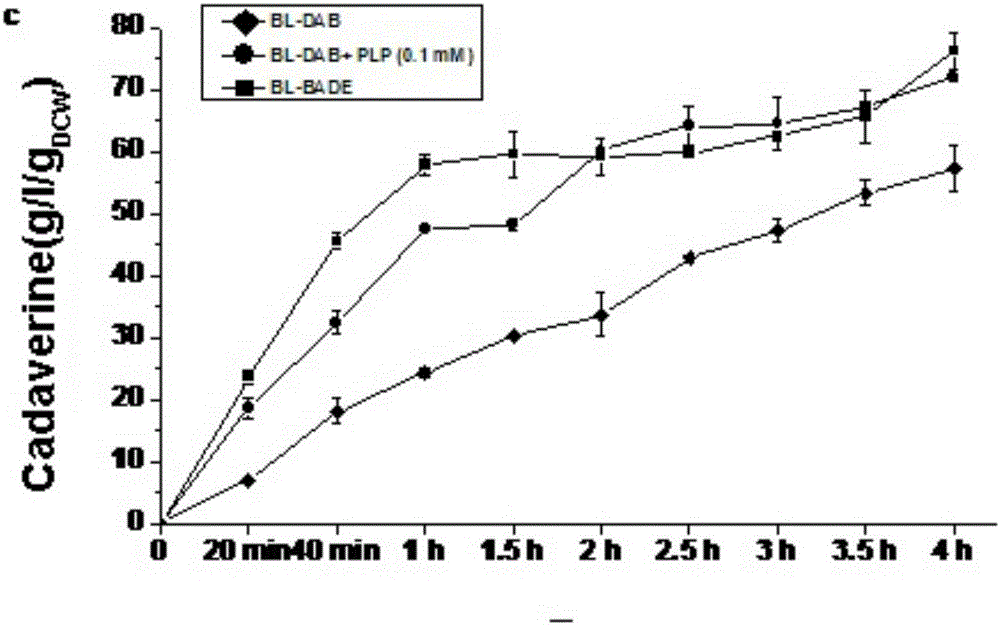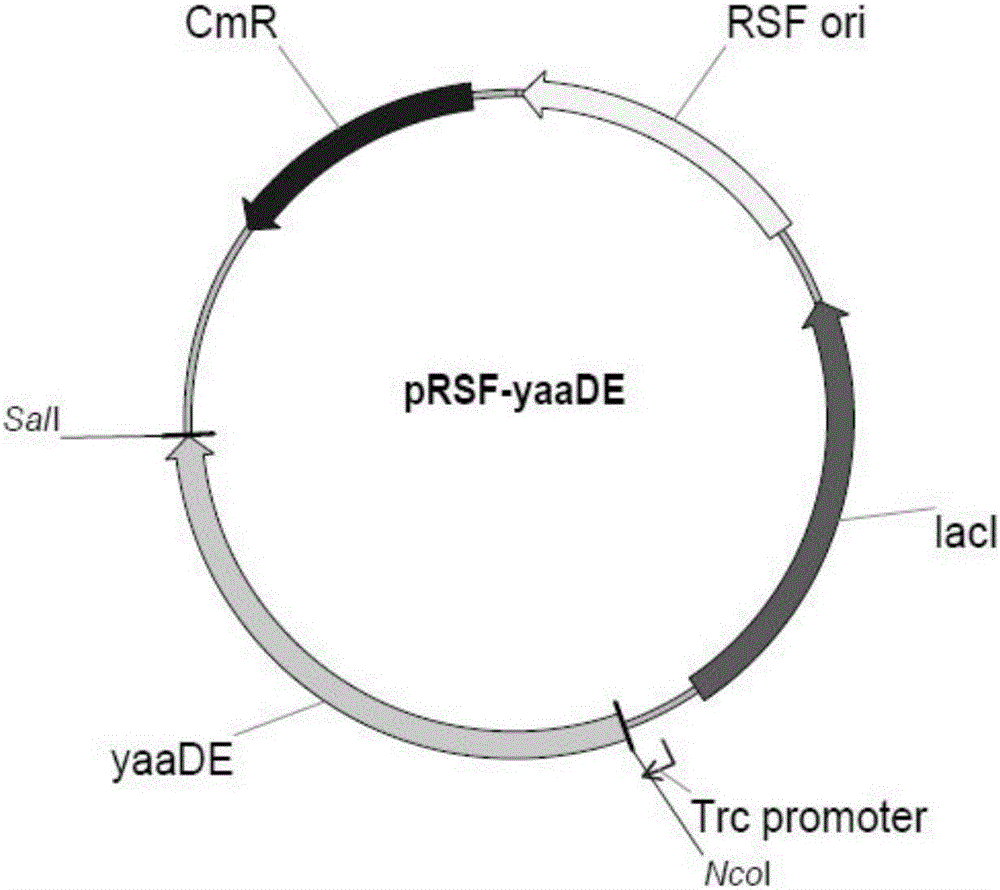Genetically engineered bacteria and application of genetically engineered bacteria in production of 1,5-pentanediamine
A technology of genetically engineered bacteria and uses, applied in the field of biocatalysis, can solve problems such as low synthesis efficiency and inability to meet, and achieve the effects of high bacterial activity, normal growth, and efficient synthesis.
- Summary
- Abstract
- Description
- Claims
- Application Information
AI Technical Summary
Problems solved by technology
Method used
Image
Examples
Embodiment 1
[0036] Example 1 Construction of 1,5-pentanediamine-producing strain
[0037] Bacillus subtilis Bacillus subtilis (GenBank: AL009126.3)
[0038] Primers designed for the pyridoxal phosphate synthase gene sequence:
[0039] YaaDE-NcoI-F: CATGccATGGCTCAAACAGGTACTGAACG;
[0040] YaaDE-SalI-R: ACGCGTCGACTTATACAAGTGCCTTTTGCTTATATTCCTCAACC.
[0041] The yaaDE gene obtained by PCR was cloned into the plasmid pRSF plasmid, and the plasmid pRSF-yaaDE ( figure 1 ). The yaaDE nucleotide sequence is as SEQ ID NO: 1, the plasmid pETDuet-pelB-CadB-CadA (see the inventor's published patent application literature: the title of the invention is an expression recombinant vector and its application, application publication number CN104498519A) and pRSF-yaaDE was introduced into Escherichia coli BL21 (DE3) by conventional methods, and the strain was named BL-BADE, and was preserved in the form of glycerol bacteria or freeze-dried strains.
Embodiment 2
[0042] Example 2 Effect of exogenous addition of pyridoxal phosphate (PLP) on the synthesis of 1,5-pentanediamine
[0043] Pick BL-DAB (see the inventor's published patent application literature: the title of the invention is an expression recombinant vector and its application, application publication number CN104498519A) single colony in 5ml LB liquid medium containing 100 ug / ml ampicillin , 37°C, 200 rpm overnight to activate the strain. The activated strains were transferred to 50 ml liquid fermentation medium containing corresponding antibiotics (100 ug / ml ampicillin) at 1% inoculum, and cultured at 37°C and 200 rpm until the OD600 was about 0.5. Add IPTG to a final concentration of 0.5 mM, induce culture at 30 °C, 200 rpm for 12 hours, and then collect the bacterial cells by centrifugation at 4000 x g, wash twice with 0.9% sodium chloride solution, and resuspend with the transformation reaction solution to a cell concentration of 4 g ( DCW) / l, the conversion reaction so...
Embodiment 3
[0046] Example 3 Transformation of genetically engineered bacteria to produce 1,5-pentanediamine
[0047] Pick a single colony of BL-BADE and place it in 5ml LB liquid medium containing 100 ug / ml ampicillin, activate the strain overnight at 37°C and 200 rpm. The activated strains were transferred to 50 ml liquid fermentation medium containing corresponding antibiotics (100 ug / ml ampicillin, 170 μg / ml chloramphenicol) at 1% inoculum, and cultivated at 37°C and 200 rpm until the OD600 was about 0.5. Add IPTG to a final concentration of 0.5 mM, induce culture at 30 °C, 200 rpm for 12 hours, and then collect the bacterial cells by centrifugation at 4000 x g. Take 10 mg (dry weight) of bacterial cells to detect the intracellular PLP content. The remaining bacteria were washed twice with 0.9% sodium chloride solution, and then resuspended with the transformation reaction solution to a cell concentration of 2 g (DCW) / l. The transformation reaction solution contained L-lysine hydroch...
PUM
| Property | Measurement | Unit |
|---|---|---|
| wavelength | aaaaa | aaaaa |
Abstract
Description
Claims
Application Information
 Login to View More
Login to View More - R&D
- Intellectual Property
- Life Sciences
- Materials
- Tech Scout
- Unparalleled Data Quality
- Higher Quality Content
- 60% Fewer Hallucinations
Browse by: Latest US Patents, China's latest patents, Technical Efficacy Thesaurus, Application Domain, Technology Topic, Popular Technical Reports.
© 2025 PatSnap. All rights reserved.Legal|Privacy policy|Modern Slavery Act Transparency Statement|Sitemap|About US| Contact US: help@patsnap.com



